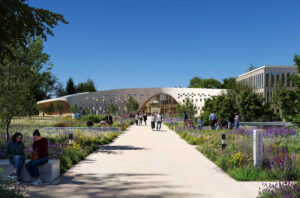Education technology (edtech) in business education is gaining momentum with the MBA program receiving the most investment for digital teaching, according to a new global report.
Three quarters (75%) of Business School leaders say that their Schools are now using virtual classrooms – an increase from 51% at the end of 2020, according to the AMBA & BGA Education Technology Report
This report, based on a survey of 171 Business School leaders worldwide, tells the story of edtech in 2020 and 2021. In so doing, it reveals how Business Schools turned a crisis into an opportunity.
The report revealed that the MBA is the program receiving the most funding for digital teaching methods with 83% of participants saying that their Business School is investing a moderate amount or more in this program.
Following a year in which Business Schools were pushed into enhancing their investments in edtech by the Covid-19 pandemic and associated restrictions, 84% of participants to this survey have indicated that they want their Business School to retain the new technology that has been introduced.
Responding Business School leaders are also keen to keep aspects of faculty teaching online (62%) and students not coming to campus (65%), suggesting that their preference for the future is hybrid or blended models of learning.
Most Business School leaders believe that the pandemic has triggered major changes to their institution’s long-term strategy and 82% are planning to invest further in technology over the coming two years to enable online teaching.
Key findings
Format of teaching
- 75% of respondents said their Business School uses a virtual classroom, an increase from 51% last year.
- 25% of responding Business leaders said that their institution is using virtual reality (VR) to teach programmes, while 61% of participants said their School is not using this technology (14% were unsure). The majority (65%) of participants indicate that this technology is being used to teach in a more exciting way.
Synchronous vs. asynchronous learning
- The biggest advantage of both synchronous and asynchronous digital teaching methods is seen by participants to be less travel for students, as cited by 74% of participants.
- 54% expressed their belief that asynchronous digital teaching methods offer a worse experience for learners than classroom teaching. A smaller proportion, of 38%, said they believe synchronous digital teaching methods are inferior to classroom methods, in terms of learning experience.
- Whether online instruction is asynchronous or synchronous, the biggest problem experienced by Business Schools is identifying gaps in students’ knowledge (as reported by 69% and 55% of respondents, respectively).
- Lack of student engagement (64%); student connection issues (54%) and adapting programmes to suit online teaching formats (53%) are the most frequently cited challenges faced by Business School leaders when delivering online education in a synchronous format.
- 93% of respondents said they believe that facilitators/faculty are either ‘very satisfied’ or ‘fairly satisfied’ with the current synchronous digital teaching technologies.
Impact of Covid-19
- 84% of participants said they want their Business School to retain the technology that has been implemented during the pandemic – 16% want to keep aspects of it, but none want this technology discarded altogether.
- Responding Business School leaders are also keen to keep aspects of ‘faculty teaching online’ (62%) and ‘students not coming to campus’ (65%), suggesting that their preference for the future is hybrid or blended models of learning.
- 83% of Business School leaders said they believe that the pandemic has triggered major changes to their institution’s long-term strategy, while 17% said they believe that it has not.
Investment
- The MBA is the programme which is receiving the most funding for digital teaching methods – 83% of participants said that their Business School is investing a moderate amount or more in this programme in this way.
- Providing ‘flexibility in learning’ is the most popular purpose of existing investment in relation to online learning technologies, as cited by 77% of Business School leaders.
- ‘Flexibility in learning’ is also top of Schools’ minds when looking ahead to the next two years, for which it is cited as a priority for investment by 67% of respondents. Other top priorities include the enhancement of soft skills (cited by 57%) and student engagement metrics (45%).
- 82% of Business School leaders said their School is planning to invest further in technology over the coming two years to enable online teaching.
David Woods-Hale, Director of Marketing and Communications at AMBA & BGA, said: “In January 2021, when AMBA & BGA released the first iteration of its Education Technology Report, in association with Barco, the overarching takeaway was that things would never be the same as they were pre-Covid-19, and that a new era – one we’d only previously debated and considered – had arrived almost overnight.
“The Business School leaders who took part in that research showed their Schools to be both pragmatic and agile in the face of the disruption caused during 2020. Initially reactive to the need for the rapid adoption of new technology in the face of social distancing, they then ascertained challenges quickly and moved to address them.
“But, at that time, commentators in both the edtech and business education arenas were questioning whether Business Schools would be continuing to adapt to the impact of Covid-19, or if they would enter a new phase of innovation – moving from crisis mode to creative strategy and the development and finetuning of technology provision, as the world began to move into recovery, once the availability of vaccines began to reduce the impact of Covid-19 in many parts of the world.
“Nine months on, this fresh piece of research reveals that Business Schools have more than adapted and that the vast majority of Business School leaders (84%) want to keep the technology they’ve put in place over the past 18 months, with no respondents wishing to return to their pre-Covid status quo.
“Approximately two thirds of participants would like to see faculty and students continuing to work online in at least some aspects of the courses, suggesting that Business School leaders would like to see their Business School move to hybrid or blended models of education.
“But perhaps most importantly, an overwhelming 83% of Business School leaders believe that the pandemic has triggered major changes to their long-term strategy. While the jury was divided towards the end of 2020 (among those responding to the report released in January 2021), Business School leaders are now seemingly confident that blended and hybrid models will replace the traditional classroom-based delivery of courses over the next five years. Since the end of last year, there has also been an increase of 24 percentage points in terms of the volume of survey respondents using virtual classrooms (75% in 2021 vs. 51% at the end of 2020).
“While there is a sense of optimism in the long-term future of digital learning at Business Schools, challenges remain – not least in terms of a perceived lack of engagement from students (cited by 64% of survey participants), connection and bandwidth issues from students (cited by 54%) and the need for ongoing amends to course materials required for digital delivery (cited by 53%).
“Yet, it is flexibility of learning, rather than concerns about delivery, that has moved to the forefront of Business School leaders’ minds, in terms of their investment priorities for the next two years, with more than two thirds (67%) of leaders believing that is where their Business School must put its effort and budget.
“While Covid-19 still looms large over strategists for any immediate initiatives, the exponential change and evolution witnessed at Business Schools over the past two years has begun to address lingering challenges with which educators had been grappling for years – globalisation, volatility, flexible learning, lifelong learning, consumerisation, the influx of digital natives, to name but a few. Now that the mechanics are in place for Business Schools to use technology effectively, the opportunities for business education to further develop global, agile and personalised offerings seem limitless.”







